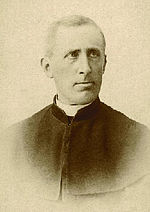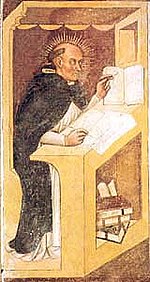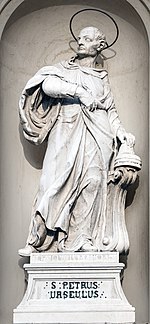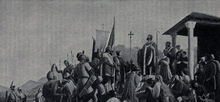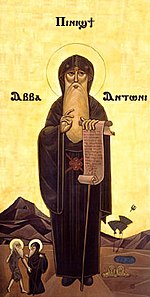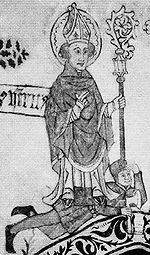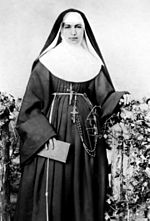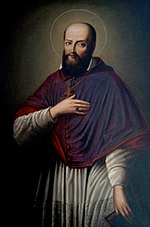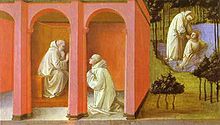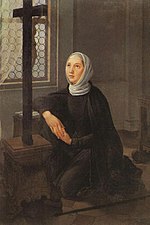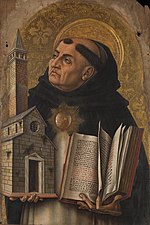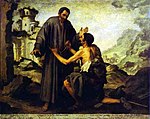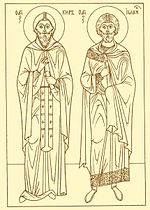Portal:Catholic Church/Patron Archive/January
Patron Archive
January - February - March - April - May - June - July - August - September - October - November - December
Today is Monday, January 13, 2025; it is now 20:50 UTC
Zygmunt Gorazdowski (1 November 1845 – 1 January 1920) was a Polish Roman Catholic priest and the founder of the Sisters of Saint Joseph. Gorazdowski suffered from tuberculosis during his childhood which impeded his studies for the priesthood in what required him to take time off in order to recover before he could be ordained. Once he was ordained he served in various parishes while setting up homes for orphans and single mothers as well as hospices and other establishments for a range of people; he was a prolific writer of catechism and other religious notes for the benefit of his flock. (Full article...)
Attributes: Priest's attire
Patronage: Sisters of Saint Joseph; Sanok
See also: Fulgentius of Ruspe, Giuseppe Maria Tomasi
Basil of Caesarea, also called Saint Basil the Great (Koinē Greek: Ἅγιος Βασίλειος ὁ Μέγας, Hágios Basíleios ho Mégas; Coptic: Ⲡⲓⲁⲅⲓⲟⲥ Ⲃⲁⲥⲓⲗⲓⲟⲥ, Piagios Basílios; 330 – 1 or 2 January 379), was an early Roman Christian prelate who served as Bishop of Caesarea in Cappadocia from 370 until his death in 379. He was an influential theologian who supported the Nicene Creed and opposed the heresies of the early Christian church, fighting against both Arianism and the followers of Apollinaris of Laodicea. (Full article...)
Prayer: Your voice resounded throughout the world that received your word by which, in godly manner, you taught dogma, clarified the nature of beings, and set in order the character of people. Venerable father, Royal Priesthood, intercede to Christ God to grant us great mercy.
Attributes: Vested as bishop, wearing omophorion, holding a Gospel Book or scroll. St. Basil is depicted in icons as thin and ascetic with a long, tapering black beard.
Patronage: Russia, Cappadocia, Hospital administrators, Reformers, Monks, Education, Exorcism, Liturgists
See also: Gregory of Nazianzus; Seraphim of Sarov
Genevieve (French: Sainte Geneviève; Latin: Genovefa; also called Genovefa and Genofeva; c. 419/422 AD – 502/512 AD) was a consecrated virgin, and is one of the two patron saints of Paris in the Catholic and Orthodox traditions. Her feast day is on 3 January.
Recognized for her religious devotion at a young age, she met Germanus of Auxerre and Lupus of Troyes when she was a child and dedicated herself to a virginal life. Miracles and healings began to happen around her early on and she became known for changing the weather. She moved from Nanterre, her hometown, to Paris, after her parents died and became known for her piety, healings, and miracles, although the residents of Paris resented her and would have killed her if not for Germanus' interventions. Her prayers saved Paris from being destroyed by the Huns under Attila in 451 and other wars; her organisation of the city's women was called a "prayer marathon" and Genevieve's "most famous feat". She was involved in two major construction projects in Paris, a basilica in the honour of Saint Denis of Paris in 475 and the Basilica of the Holy Apostles, dedicated to Saint Peter and Saint Paul c. 500. (Full article...)
Prayer: Saint Genevieve, you who by the days before, penance and prayer, ensured the protection of Paris, intercede near God for us, for our country, for the devoted Christian hearts. You who cured the sick and fed the hungry, obtain the light of God and make us stronger to reject temptation. You who had the concern of the poor, protect the sick, the abandoned, and the unemployed. You who resisted the armies and encouraged the besieged, give us the direction for truth and justice. You who through the centuries never ceased taking care of your people, help us to keep the teachings of our Lord Jesus Christ. May your example be for us, an encouragement to always seek God and serve him through our brothers and sisters. Amen.
Attributes: shepherdess with crook and wallet, as aristocratic virgin with devil and angel or with a burning light or two keys (of Paris) in the hand
Patronage: Paristhe religious order and clubs, named after her, women, shepherds, hatters, wax-chandlers, vine dressers, against war, dryness, pest, fever and sickness of the eyes
Elizabeth Ann Bayley Seton SC (August 28, 1774 – January 4, 1821) was a Catholic religious sister in the United States and an educator, known as a founder of the country's parochial school system. Born in New York and reared as an Episcopalian, she married and had five children with her husband William Seton. Two years after his death, she converted to Catholicism in 1805. (Full article...)
Prayer: We must pray literally without ceasing--without ceasing--in every occurrence and employment of our lives . . . that prayer of the heart which is independent of place or situation, or which is rather a habit of lifting up the heart to God as in a constant communication with Him.
Attributes: -
Patronage: Catholic Schools; seafarers; widows; Shreveport, Louisiana; and the State of Maryland
See also: Apollinaris Syncletica; Angela of Foligno; Manuel González García, Spain; Zdislava Berka, Czech Republic
John Nepomucene Neumann CSsR (German: Johann Nepomuk Neumann, Czech: Jan Nepomucký Neumann, Latin: Ioannes Nepomucenus Neumann; March 28, 1811 – January 5, 1860) was a Bohemian-born American prelate of the Catholic Church. (Full article...)
Attributes: Redemptorist habit with a pectoral cross
Patronage: -
See also: Syncletica of Alexandria, Egypt; Charles of Mount Argus, Ireland; Genoveva Torres Morales, Spain
In Christianity, the Biblical Magi (/ˈmeɪdʒaɪ/ MAY-jy or /ˈmædʒaɪ/ MAJ-eye; singular: magus), also known as the Three Wise Men, Three Kings, and Three Magi, are distinguished foreigners who visit Jesus after his birth, bearing gifts of gold, frankincense, and myrrh in homage to him. They are commemorated on the feast day of Epiphany—sometimes called "Three Kings Day"—and commonly appear in the nativity celebrations of Christmas.
The Magi appear solely in the Gospel of Matthew, which states that they came "from the east" (Greek ἀπὸ ἀνατολῶν - apo anatolōn) to worship the "one who has been born king of the Jews". Their names, origins, appearances, and exact number are unmentioned and derive from the inferences or traditions of later Christians. In Western Christianity, they are usually assumed to have been three in number, corresponding with each gift; in Eastern Christianity, especially the Syriac churches, they often number twelve. Likewise, the Magi's social status is never stated: although some biblical translations describe them as astrologers, they were increasingly identified as kings by at least the third century, which conformed with Christian interpretations of Old Testament prophecies that the messiah would be worshipped by kings. (Full article...)
Attributes: With rich oriental clothes, with presents in front of the crib, one of them with dark skin color
Patronage: Town of Cologne, travelers, pilgrims, furriers, producers of playing cards, against storm and epilepsy
See also: Rafaela Porras Ayllón; Juan de Ribera, Spain; Charles of Sezze; André Bessette, Canada
Raymond of Penyafort OP (Catalan: Sant Ramon de Penyafort, IPA: [ˈsan rəˈmon də ˌpɛɲəˈfɔɾ]; c. 1175 – 6 January 1275) was a Catalan friar with the Dominicans who was a canon lawyer. He compiled the Decretals of Gregory IX, a collection of canonical laws that remained a major part of Church law until the 1917 Code of Canon Law abrogated it. He was canonized by Pope Clement VIII in 1601 and is the patron saint of canon lawyers. (Full article...)
Attributes: Skimming across the sea with his cape as both boat and sail
Patronage: canon lawyers; all types of lawyers (Spain)
See also: Angela of Foligno
Gudula of Brabant, also known as Saint Gudula (ca. 646–712), was a Christian saint who is venerated in Catholic and Orthodox churches. In Brabant, she is usually called Goedele or Goule; (Latin: Gudila, later Gudula; Dutch: Goedele; French: Gudule). Her name is connected to several places: Moorsel (where she lived), Brussels (where a chapter in her honour was founded in 1047) and Eibingen (where the relic of her skull is conserved). (Full article...)
Attributes: depicted as a woman with lantern which the devil tries to blow out
Patronage: Brussels; single laywomen
See also: Apollinaris Claudius
Adrian, also spelled Hadrian (born before 637, died 710), was a North African scholar in Anglo-Saxon England and the abbot of Saint Peter's and Saint Paul's in Canterbury. He was a noted teacher and commentator of the Bible. Adrian was born between 630 and 637. According to Bede, he was "by nation an African", and thus a Berber native of North Africa, and was abbot of a monastery near Naples, called Monasterium Niridanum (perhaps a mistake for Nisidanum, as being situated on the island of Nisida). (Full article...)
Attributes: as a bishop
Patronage: -
Pietro I Orseolo OSBCam, also known as Peter Urseulus, (928–987) was the Doge of Venice from 976 until 978. He abdicated his office and left in the middle of the night to become a monk. He later entered the order of the Camaldolese Hermits of Mount Corona. He is venerated as a saint in the Eastern Orthodox Church and Roman Catholic Church. (Full article...)
Attributes: habit of a monk or clothes of the doge
Patronage: -
See also: Gregory of Nyssa; Leonie Aviat, France
Saint Paulinus II (c. 726 – 11 January 802 or 804 AD) was a priest, theologian, poet, and one of the most eminent scholars of the Carolingian Renaissance. From 787 to his death, he was the Patriarch of Aquileia in what is now northeastern Italy. He participated in a number of synods which opposed Spanish Adoptionism and promoted both reforms and the adoption of the Filioque into the Nicene Creed. In addition, Paulinus arranged for the peaceful Christianisation of the Avars and the alpine Slavs in the territory of the Aquileian patriarchate. For this, he is also known as the apostle of the Slovenes. (Full article...)
Attributes: -
Patronage: -
See also: Tommaso da Cori
The baptism of Jesus, the ritual purification of Jesus with water by John the Baptist, was a major event described in the three synoptic Gospels of the New Testament (Matthew, Mark and Luke). It is considered to have taken place at Al-Maghtas (also called Bethany Beyond the Jordan), today located in Jordan. (Full article...)
Attributes: -
Patronage: -
Hilary of Poitiers (Latin: Hilarius Pictaviensis; c. 310 – c. 367) was Bishop of Poitiers and a Doctor of the Church. He was sometimes referred to as the "Hammer of the Arians" (Malleus Arianorum) and the "Athanasius of the West". His name comes from the Latin word for happy or cheerful. In addition to his important work as bishop, Hilary was married and the father of Abra of Poitiers, a nun and saint who became known for her charity. (Full article...)
Attributes: episcopal vestments, a mitre and crozier, and a beard, usually white and often long
Patronage: -
Kentigern (Welsh: Cyndeyrn Garthwys; Latin: Kentigernus), known as Mungo, was a missionary in the Brittonic Kingdom of Strathclyde in the late sixth century, and the founder and patron saint of the city of Glasgow. (Full article...)
Attributes: bishop with a robin on his shoulder; holding a bell and a fish with a ring in its mouth
Patronage: Glasgow; Scotland; Penicuik; salmon; those accused of infidelity; against bullies
Íte ingen Chinn Fhalad (d. 570/577), also known as Íde, Ita, Ida or Ides, was an early Irish nun and patron saint of Killeedy (Cluain Credhail). She was known as the "foster mother of the saints of Erin". The name "Ita" ("thirst for holiness") was conferred on her because of her saintly qualities. Her feast day is 15 January. (Full article...)
Attributes: -
Patronage: Roman Catholic Diocese of Limerick, Ireland, Killeedy, Ireland
See also: Arnold Janssen
Joseph Vaz, CO (21 April 1651 – 16 January 1711) was an Oratorian priest and missionary in Sri Lanka (Ceylon). Originally from Sancoale in Portuguese India, Vaz arrived in Ceylon during the Dutch occupation, a time when the Dutch had banned Catholicism in Ceylon and imposed Calvinism as the official religion after taking control from the Portuguese Empire.
He travelled throughout the island bringing the Eucharist and the Sacraments to clandestine groups of crypto-Catholics. Later in his mission, he found shelter in the Kingdom of Kandy where he was able to work freely. By the time of his death, Vaz had managed to rebuild the Catholic Church on the island. (Full article...)
Attributes: Mitre placed to side, holding crucifix, sun icon, Oratorian habit
Patronage: Sri Lanka
See also: Honoratus
Anthony the Great (Ancient Greek: Ἀντώνιος ὁ Μέγας Antónios ho̅ Me̅́gas; Arabic: القديس أنطونيوس الكبير; Latin: Antonius; Coptic: Ⲁⲃⲃⲁ Ⲁⲛⲧⲱⲛⲓ; c. 12 January 251 – 17 January 356) was a Christian monk from Egypt, revered since his death as a saint. He is distinguished from other saints named Anthony, such as Anthony of Padua, by various epithets: Anthony of Egypt, Anthony the Abbot, Anthony of the Desert, Anthony the Anchorite, Anthony the Hermit, and Anthony of Thebes. For his importance among the Desert Fathers and to all later Christian monasticism, he is also known as the Father of All Monks. His feast day is celebrated on 17 January among the Eastern Orthodox and Catholic churches and on Tobi 22 in the Coptic calendar. (Full article...)
Attributes: Bell; pig; book; Tau Cross; Tau cross with bell pendant
Patronage: Animals, skin diseases, farmers, butchers, basket makers, brushmakers, gravediggers; Pontifical Ecclesiastical Academy, Rome;
Margaret of Hungary, OP (Margit in Hungarian; January 27, 1242 – January 18, 1270) was a Dominican nun and the daughter of King Béla IV of Hungary and Maria Laskarina. She was the younger sister of Kinga of Poland (Kunegunda) and Yolanda of Poland and, through her father, the niece of the famed Elizabeth of Hungary. (Full article...)
Attributes: A lily and a book
Patronage: -
Henry (Finnish: Henrik; Swedish: Henrik; Latin: Henricus; died c. 20 January 1156) was a medieval English clergyman. He came to Sweden with Cardinal Nicholas Breakspeare in 1153 and was most likely designated to be the new Archbishop of Uppsala, but the independent church province of Sweden could only be established in 1164 after the civil war, and Henry would have been sent to organize the Church in Finland, where Christians had already existed for two centuries. (Full article...)
Attributes: -
Patronage: Catholic Cathedral of Helsinki
See also: Germanicus of Smyrna; Józef Sebastian Pelczar, Poland
Pope Fabian (Latin: Fabianus) was the bishop of Rome from 10 January 236 until his death on 20 January 250, succeeding Anterus. A dove is said to have descended on his head to mark him as the Holy Spirit's unexpected choice to become the next pope. He was succeeded by Cornelius. (Full article...)
Prayer: Pope Saint Fabian, it's so easy to believe that peace means a life without conflict or suffering. Help us to see that the only true peace is the peace Christ brings. Never let us as a Church or as individual Christians choose to deny our beliefs simply to avoid an unpleasant situation. Amen
Attributes: Dove, Papal vestments, Papal tiara
Patronage: -
See also: Saint Sebastian; Eustochia Smeralda Calafato; Maria Cristina of the Immaculate Conception Brando
Agnes of Rome (c. 291 – c. 304) is a virgin martyr, venerated as a saint in the Catholic Church, Oriental Orthodox Church and the Eastern Orthodox Church, as well as the Anglican Communion and Lutheran Churches. She is one of several virgin martyrs commemorated by name in the Canon of the Mass, and one of many Christians martyred during the reign of the Roman emperor Diocletian.
Agnes was born in 291 into Roman nobility, and raised as a Christian. She suffered martyrdom on 21 January 304, aged 12 or 13. Her high-ranking suitors, slighted by her resolute devotion to religious purity, sought to persecute her for her beliefs. Her father urged her to deny God, but she refused, and she was dragged naked through the streets to a brothel, then tried and sentenced to death. She was eventually beheaded, after attempts for her to be burnt at the stake failed. A few days after her death, her foster-sister Emerentiana was found praying by her tomb, and was stoned to death. (Full article...)
Attributes: a lamb, martyr's palm
Patronage: Betrothed couples; chastity and virgins; Children of Mary; Colegio Capranica of Rome; gardeners; Girl Guides; the diocese of Rockville Centre, New York; the city of Fresno
See also: Alban Roe, England
Vincent of Saragossa (also known as Vincent Martyr, Vincent of Huesca or Vincent the Deacon), the Protomartyr of Spain, was a deacon of the Church of Saragossa. He is the patron saint of Lisbon, Algarve, and Valencia. His feast day is 22 January in the Catholic Church, Anglican Communion, and the Eastern Orthodox Church, with an additional commemoration on 11 November in the Eastern Orthodox Church. He was born at Huesca and martyred under the Emperor Diocletian around the year 304. (Full article...)
Attributes: Usually pontifical, episcopal, etc. insignia, tools of martyrdom and so forth
Patronage: São Vicente, Lisbon; Diocese of Algarve; Valencia; Vicenza, Italy, vinegar-makers, wine-makers; Order of Deacons of the Catholic Diocese of Bergamo (Italy)
See also: Vincent Pallotti; Caterina Volpicelli
Marianne Cope, OSF (also known as Saint Marianne of Molokaʻi) (January 23, 1838 – August 9, 1918), was a German-born American religious sister who was a member of the Sisters of St. Francis of Syracuse, New York, and founding leader of its St. Joseph's Hospital in the city, among the first of 50 general hospitals in the country. Known also for her charitable works, in 1883 she relocated with six other sisters to Hawaiʻi to care for persons suffering leprosy on the island of Molokaʻi and aid in developing the medical infrastructure in Hawaiʻi. Despite direct contact with the patients over many years, Cope did not contract the disease. (Full article...)
Attributes: -
Patronage: Lepers, outcasts, those with HIV/AIDS, Hawaiʻi
See also: Saint Emerentiana
Francis de Sales, C.O., O.M. (French: François de Sales; Italian: Francesco di Sales; 21 August 1567 – 28 December 1622) was a Savoyard Catholic prelate who served as Bishop of Geneva and is a saint of the Catholic Church. He became noted for his deep faith and his gentle approach to the religious divisions in his land resulting from the Protestant Reformation. He is known also for his writings on the topic of spiritual direction and spiritual formation, particularly the Introduction to the Devout Life and the Treatise on the Love of God. (Full article...)
Prayer: O love eternal, my soul needs and chooses you eternally! Ah, come Holy Spirit, and inflame our hearts with your love! To love -- or to die! To die -- and to love! To die to all other love in order to live in Jesus' love, so that we may not die eternally; but that we may live in your eternal love, O Savior of our souls, we eternally sing, "Live, Jesus! Jesus, I love! Live, Jesus, whom I love! Jesus, I love, Jesus who lives and reigns forever and ever. AMEN
Attributes: Heart of Jesus, Crown of Thorns
Patronage: Baker, Oregon; Cincinnati, Ohio; Catholic press; Columbus, Ohio; confessors; deaf people; educators; Upington, South Africa; Wilmington, Delaware; writers; journalists; the Institute of Christ the King Sovereign Priest; Salesians of Don Bosco
Maurus, OSB (French: Maur; Italian: Mauro) (512–584) was an Italian Catholic monk best known as the first disciple of Benedict of Nursia. He is mentioned in Gregory the Great's biography of the latter as the first oblate, offered to the monastery by his noble Roman parents as a young boy to be brought up in the monastic life.
Four stories involving Maurus recounted by Gregory formed a pattern for the ideal formation of a Benedictine monk. The most famous of these involved Maurus's rescue of Placidus, a younger boy offered to Benedict at the same time as Maurus. The incident has been reproduced in many medieval and Renaissance paintings. (Full article...)
Attributes: crutch; weighing scale; young man in garb of a monk, holding an abbot's cross and spade
Patronage: cripples; invoked against rheumatism, epilepsy, gout, hoarseness, cold; Azores; charcoal burners; cobblers; coppersmiths; shoemakers
See also: Saint Apollos
Paula of Rome (AD 347–404) was an ancient Roman Christian saint and early Desert Mother. A member of one of the richest senatorial families which claimed descent from Agamemnon, Paula was the daughter of Blesilla and Rogatus, from the great clan of the. At the age of 16, Paula was married to the nobleman Toxotius, with whom she had four daughters, Blaesilla, Paulina, Eustochium, and Rufina. She also had a boy, also named Toxotius. As a disciple of Jerome, she is considered the first nun in the history of Christianity. (Full article...)
Attributes: Depicted as a Hieronymite abbess with a book; depicted as a pilgrim, often with St. Jerome and St. Eustochium; depicted prostrate before the cave at Bethlehem; depicted embarking in a ship, while a child calls from the shore; weeping over her children; with the instruments of the Passion; holding a scroll with Saint Jerome's epistle Cogite me Paula; with a book and a black veil fringed with gold; or with a sponge in her hand.
Patronage: Widows; Order of Saint Jerome monks and nuns
See also: Saint Timothy; Saint Titus
Angela Merici (/məˈriːtʃi/ mə-REE-chee; Italian: [ˈandʒela (de) meˈriːtʃi]; 21 March 1474 – 27 January 1540) was an Italian Catholic religious educator who founded the Company of St. Ursula in 1535 in Brescia, in which women dedicated their lives to the service of the church through the education of girls. (Full article...)
Attributes: cloak, ladder
Patronage: sickness, handicapped people, loss of parents
See also: Enrique de Ossó i Cervelló, Spain
Thomas Aquinas OP (/əˈkwaɪnəs/ ⓘ ə-KWY-nəs; Italian: Tommaso d'Aquino, lit. 'Thomas of Aquino'; c. 1225 – 7 March 1274) was an Italian Dominican friar and priest, the foremost Scholastic thinker, as well one of the most influential philosophers and theologians in the Western tradition. He was from the county of Aquino in the Kingdom of Sicily. (Full article...)
Attributes: The Summa theologiae; a model church; the sun on the chest of a Dominican friar
Patronage: Academics; against storms; against lightning; apologists; Aquino, Italy; Belcastro, Italy; book sellers; Catholic academies, schools, and universities; chastity; Falena, Italy; learning; pencil makers; philosophers; publishers; scholars; students; University of Santo Tomas; Sto. Tomas, Batangas; Mangaldan, Pangasinan; theologians
See also: Joseph Freinademetz; Jaime Hilario Barbal, Spain
Juniper, also known as Brother Juniper (Italian: Fra Ginepro) (died 1258), called "the renowned jester of the Lord", was one of the original followers of Francis of Assisi. Not much is known about Juniper before he joined the friars. In 1210, he was received into the Order of Friars Minor by Francis himself. "Would to God, my brothers, that I had a whole forest of such Junipers," Francis would delightfully pun.
Francis sent him to establish "places" for the friars in Gualdo Tadino and Viterbo. When Clare of Assisi was dying, Juniper consoled her. Juniper is buried at Ara Coeli Church at Rome. (Full article...)
Attributes: -
Patronage: -
See also: Saint Francis Taylor
Hyacintha Mariscotti, or Hyacintha of Mariscotti (Italian: Giacinta Marescotti), was an Italian religious sister of the Third Order Regular of St. Francis. She was born in 1585 of a noble family at Vignanello, in the Province of Viterbo, and died 30 January 1640 in Viterbo, noted for the depth of her spiritual gifts. She is honored as a saint in the Catholic Church. (Full article...)
Attributes: -
Patronage: -
See also: Sebastian Valfrè; Mutien-Marie Wiaux, Belgium
Saints Cyrus and John (Italian: Ciro e Giovanni; Arabic: أباكير ويوحنا, romanized: Abākīr wa-Yūḥannā; died c. 304 or 311 AD) are venerated as martyrs. They are especially venerated by the Coptic Church and surnamed Wonderworking Unmercenaries (thaumatourgoi anargyroi) because they healed the sick free of charge.
Their feast day is celebrated by the Copts on the sixth day of Tobi, corresponding to 31 January, the day also observed by the Eastern Orthodox Church; on the same day they are commemorated in the Roman Martyrology. The Eastern Orthodox Church also celebrate the finding and translation of their relics on 28 June. (Full article...)
Attributes: Cyrus is clothed in monastic habit, John is wearing court robes. They may be shown holding martyrs' crosses or medicine boxes and medicine spoons which terminate in crosses
Patronage: Vico Equense
See also: Geminianus; Francis Xavier Bianchi; John Bosco

